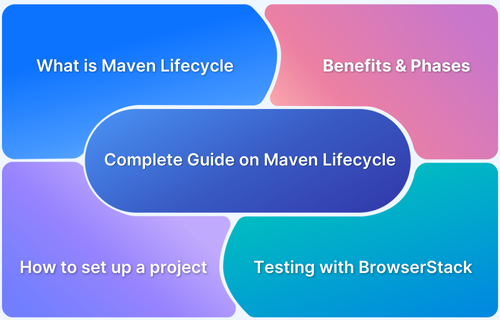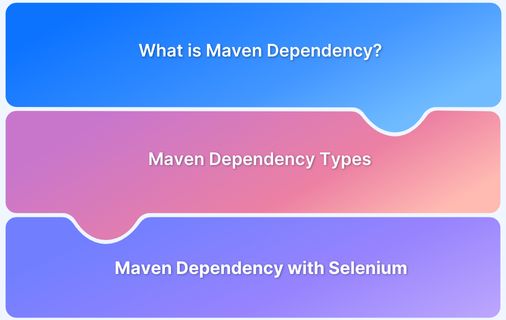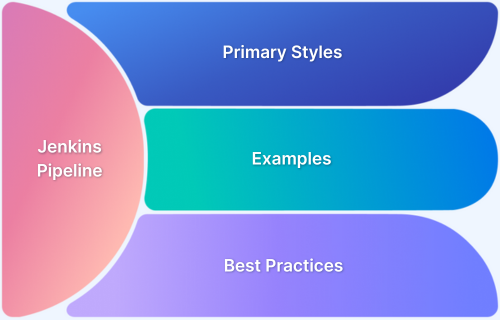Maven and Jenkins are two of the most frequently used build and integration tools in existence.
Overview
What is Maven?
Maven is an open-source build automation tool for managing Java project builds and dependencies. It ensures smooth configuration across different stages of development.
What is Jenkins?
Jenkins is an open-source automation server designed for continuous integration and continuous delivery (CI/CD). It allows developers to automate various stages of the development lifecycle.
Maven vs Jenkins: Comparison
- Maven manages dependencies and builds, while Jenkins automates the entire CI/CD pipeline.
- Maven is a build automation tool, whereas Jenkins is a CI/CD automation server.
- Maven uses XML-based configuration (pom.xml), while Jenkins uses a web interface or scripts.
- Maven integrates with Java tools like JUnit and Eclipse, whereas Jenkins integrates with a wide range of tools like GitHub, Docker, and Slack.
- Maven’s performance depends on project size and dependencies, while Jenkins’ performance is influenced by load and system resources.
This article gives a detailed comparison of Maven vs Jenkins and how to choose the right tool.
Maven vs Jenkins: Comparison
Below is a key comparison between Maven and Jenkins.
| Parameter | Jenkins | Maven |
|---|---|---|
| Developer | Created by Kohsuke Kawaguchi, initially by Sun Microsystems. | Developed by the Apache Software Foundation. |
| Release Year | 2011 | 2004 |
| Tool Type | Open-source CI/CD automation tool. | Build automation tool for Java projects. |
| License | MIT License | Apache License 2.0 |
| Purpose | Automates CI/CD processes like building, testing, and deployment. | Manages project builds and dependencies for Java. |
| Configuration | Configured via web interface or scripts. | Managed through XML files (pom.xml). |
| Integration Tools | Integrates with tools like Slack, GitHub, Docker, etc. | Integrates with JUnit, Eclipse, Jenkins, etc. |
| Performance | Performance varies with load and resources. | Dependent on project size and dependencies. |
| Use Case | Best for CI/CD workflows and automation pipelines. | Best for Java developers handling build and dependencies. |
| Companies Using It | Facebook, Netflix, Uber, LinkedIn. | CRED, Accenture, Zalando, N26. |
What is Jenkins?
Jenkins is an open-source Java automation server widely used for implementing Continuous Integration (CI) and Continuous Delivery (CD). It helps developers automate software development’s build, test, and deployment phases, making it easier to deliver high-quality software quickly and efficiently.
By integrating various tools and technologies, Jenkins orchestrates every development lifecycle stage, from compiling code to deployment.
Also Read: Continuous Delivery vs Continuous Deployment
Key Features of Jenkins
Here are the key aspects of Jenkins:
- Jenkins supports over 1,800 plugins for integrating with tools like Git, Maven, Docker, EC2, and more.
- It runs on major operating systems like Windows, Linux, and macOS and supports multiple programming languages.
- Jenkins can be customized for any project size and scaled across distributed systems with master-agent architecture.
- Backed by a large global community, Jenkins benefits from frequent updates, community-contributed plugins, and active support.
- Jenkins integrates seamlessly with version control, testing, and deployment tools like GitHub, Slack, and Selenium.
- It automates every stage – build, test, package, document, and deploy, speeding up software delivery cycles.
Also Read: CICD with Jenkins
Advantages of Jenkins
Here are the key advantages of Jenkins:
- Since every code commit is built and tested automatically, it allows for the release of new features faster and with fewer errors.
- Whenever an error appears during a test, developers receive immediate feedback and can fix issues in the code at the moment. Otherwise, debugging would be a cumbersome task, since testers couldn’t be sure which commit resulted in the bug.
- Open-source tool with great community support.
- Carries thousands of plugins which makes CI/CD operations much simpler. In case no plugin exists for a necessary task, simply create it and share it with the community.
- Built with Java and is, therefore, portable to all the major platforms.
Disadvantages of Jenkins
Below are the key limitations and disadvantages of Jenkins:
- The interface is not as user friendly when compared to some of its competitors.
- Despite being quite popular, Jenkins is not too easy to maintain since it runs on a server and requires a skilled server administrator to monitor its activity.
- Running a Jenkins CI server requires some infrastructural setup. Deploying a Jenkins CI over the cloud can be expensive.
- Spinning up a Jenkins CI server is time-consuming. It also needs maintenance and developer attention when adding a stage in the pipeline or upgrading the Jenkins CI server to incorporate new features.
What is Maven?
Maven is a POM (project object model) based build automation and project management tool written in Java. However, it is compatible with projects written in C#, Python, Ruby. In Maven, the software project is developed using its POM (Project Object Model) which includes information about the project and configuration such as construction directory, source directory, test source directory, dependency, plugins, goals, etc.
Maven primarily intends to provide developers with:
- A comprehensive, reusable, easily maintainable model for projects.
- Plugins or tools to interact with and operate with this model.
Key Features of Maven
A few Maven features worth mentioning are:
- Maven can be used to build any number of projects into predefined output types – jar, war, metadata.
- Maven can automatically download necessary files from the repository when building a project.
- Maven can integrate with a user’s source control system such as CVS in order to manage the release of a project. This can be done without any additional configuration.
- It is easy to port multiple modules of a project into Maven 3 from older versions. Maven 3 also supports all older versions.
- Maven analyzes the project dependency graph and allows for scheduling modules in parallel. This usually facilitates performance improvements.
- Maven comes with improved error reporting. It offers a link to the Maven wiki page which contains a detailed full description of every error.
Also Read: A Complete Guide on Maven Lifecycle
Advantages of Maven
Below are the advantages of Maven:
- Simple project setup aligned with best practices.
- Consistent usage across all projects, which translates to no ramp-up time required for new developers being added to a project.
- Maven makes it easy to start projects in different environments. Users do not need to handle dependencies injection, builds, processing, and other incidentals.
- Dependency management including automatic updating.
- Extensive and constantly expanding repository of libraries.
- Offers the ability to write plugins in Java or other scripting languages.
- Instant access to new features with minimal extra configuration.
Disadvantages of Maven
Here are some key disadvantages of Maven:
- If the maven code for an existing dependency is not available, then it is not possible to add that dependency at all.
- One must know the Maven command line or use an IDE with Maven integration, such as NetBeans or Eclipse.
Its learning curve is longer (there are 20-26 different build phases, plus packaging types).
Read More: What is Maven Dependency?
Is Maven a part of Jenkins?
Maven is not a part of Jenkins, but it integrates seamlessly with it. Maven is a build automation and dependency management tool for managing project builds, libraries (JARs), and lifecycles.
Within a Jenkins CI pipeline, Maven is often used to compile code, manage dependencies, and run tests, making the automation process smoother and more efficient.
By configuring Maven in Jenkins, developers can automate the entire build and test workflow for Java-based projects.
Also Read: How to build an effective CI CD pipeline
Maven vs Jenkins: Understanding Key Differences
Here is a description of the key differences between Maven and Jenkins:
- Programming Model: Maven relies heavily on XML-based POM files, which can be rigid and difficult to modularize, whereas Jenkins offers a more flexible and scriptable model that simplifies the creation and orchestration of build pipelines.
- Dependency Management: Maven excels at managing dependencies and consistently building Java applications across environments; Jenkins lacks native dependency management but can coordinate complex build steps through modular pipelines.
- Java Ecosystem Fit: Maven is tightly coupled with the Java ecosystem and can easily generate project scaffolds for frameworks like Spring Boot or Jakarta EE, while Jenkins focuses more on automating tasks and isn’t limited to Java alone.
- Tool Installation & Use: Maven is lightweight and easy to install with minimal setup; Jenkins requires a server environment and setup through a web interface but provides a richer set of CI/CD capabilities.
- Integration & Collaboration: Jenkins often uses Maven under the hood via plugins to compile, test, and package Java projects, making them complementary tools where Maven handles the build and Jenkins manages automation workflows.
- Use Case Suitability: Jenkins is best suited for managing continuous integration and delivery pipelines; Maven is ideal for building, testing, and packaging Java applications and handling dependency resolution.
- Plugin Development: Writing custom Maven plugins is generally simpler for Java developers compared to Jenkins plugins, which may require deeper knowledge of Jenkins’ architecture.
- Performance & Scalability: Maven performance depends on project structure and dependency size, while Jenkins’ performance varies based on concurrent builds, resources, and job configurations.
Also Read: Jenkins vs Ansible: Which one to Choose?
Maven vs Jenkins: How to Choose?
Choosing between Maven and Jenkins depends on your project’s goals:
- Purpose: Maven is ideal for managing builds and dependencies in Java-based projects, while Jenkins is built to automate CI/CD pipelines across development workflows.
- Project Needs: If your focus is compiling, testing, and packaging Java code, Maven fits well. Jenkins is essential for automated testing, deployment, and orchestration.
- Team Familiarity: Consider which tool your team is more comfortable with, as ease of adoption can impact productivity.
- Tool Integration: Evaluate how well each tool integrates with your existing ecosystem. Jenkins supports many plugins, while Maven works seamlessly with Java tools.
In most cases, using both together offers a robust setup, Maven handles the build, and Jenkins automates the pipeline.
Also Read: CircleCI vs Jenkins: A Detailed Comparison
Testing on Real Device Cloud with BrowserStack
Integrating real device testing into your CI/CD workflow is essential to ensuring high-quality releases, and BrowserStack fits this role perfectly.
It provides seamless integration with Jenkins, allowing teams to run automated tests across 35000+ real browsers and devices directly from their pipelines on their real device cloud.
Key Benefits of Using BrowserStack with Jenkins:
- CI Integration: Easily connect your Jenkins pipeline to BrowserStack using the official plugin.
- Secure Local Testing: Test internal or staging environments by automatically setting up and tearing down BrowserStack Local.
- Comprehensive Reporting: Access detailed test reports with videos, logs, and screenshots embedded into Jenkins job results.
- Scalable Cloud Infrastructure: Run tests in parallel on real devices and browsers, ensuring faster feedback and broader coverage.
Conclusion
Maven and Jenkins serve different but complementary roles in the development lifecycle.
Maven manages builds and dependencies, while Jenkins automates the entire CI/CD pipeline. Rather than choosing one over the other, the most effective approach is to integrate both for a seamless, automated development workflow that boosts productivity, accuracy, and delivery speed.






